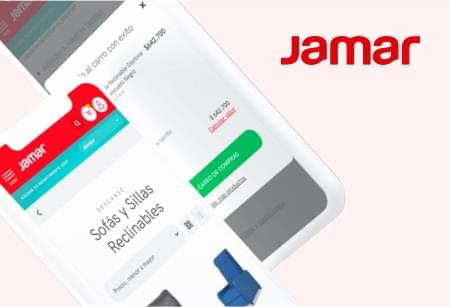App Development
Our services include but not limited to:
- B2B/B2C eCommerce Solutions
- AI and other Advanced technologies integration
- Custom eCommerce website development
- POS software and payment gateway integration
- Mobile app development
- Third-party API integrations
- eCommerce migration
- eCommerce website quality assurance testing and customer data analytics.

By partnering with Koombea, eCommerce businesses can benefit from our eCommerce development expertise and commitment to helping companies achieve their sales and customer experience goals.
In today's economy, eCommerce solutions are essential. eCommerce businesses and consumers are searching for easy and contactless methods for purchasing products and services. With Koombea's custom eCommerce web development services, you can facilitate customers' buying process, expand your business outreach, and increase revenue.
Whether you are looking for B2B or B2C eCommerce development services for your business needs, our eCommerce web developers will work with you to create a convenient and seamless online shopping experience for mobile and desktop users.
Custom eCommerce Solutions
Building a customer-centric eCommerce website can be daunting, especially if you lack the required know-how. A lot must be considered to deliver a frictionless User Experience (UX) and ensure your development process runs smoothly.
No matter what business you are in, our expert eCommerce developers are ready to help you build your dream eCommerce solution.
Custom eCommerce Development Powered by AI
Artificial intelligence (AI) is rapidly transforming the landscape of eCommerce development. We offer various solutions that enhance customer experience and business operations:

Personalization
AI algorithms analyze customer data, including purchase history, browsing behavior, and search queries, to personalize the shopping experience. This can involve recommending relevant products, offering targeted promotions, and tailoring website content based on individual preferences.

Chatbots and virtual assistants
AI-powered chatbots act as virtual assistants, answering customer questions 24/7, providing product recommendations, and facilitating the checkout process. This improves customer support efficiency and reduces the workload for human staff.

Product search and recommendations
AI can power intelligent search engines to understand natural language queries and provide accurate and relevant product suggestions. Additionally, AI can recommend complementary products based on a customer's past purchases or browsing behavior, increasing the likelihood of additional sales.

Dynamic pricing and promotions
AI algorithms can analyze market trends, competitor pricing, and customer demand to adjust pricing strategies in real-time. This allows businesses to optimize their pricing for maximum profit while remaining competitive.

Fraud prevention
AI can detect and prevent fraudulent transactions by analyzing purchase behavior and identifying suspicious patterns. This protects businesses from financial losses and enhances customer trust.

Inventory management
AI can analyze historical sales data and predict future demand, enabling businesses to optimize inventory levels and avoid stockouts or overstocking. This improves operational efficiency and reduces storage costs.
AI is revolutionizing eCommerce development by creating a more personalized, efficient, and intelligent shopping experience for customers while providing valuable insights and automation capabilities for businesses. Koombea's innovative solutions will keep your business ahead of the curve.
Enterprise eCommerce Development Services

Enterprise eCommerce Development Services
Large, well-established businesses with a high volume of sales need high-performing POS systems that are stable and capable of supporting multiple online transactions simultaneously. Through our unique eCommerce development approach, our eCommerce developers deliver:
- scalable eCommerce solutions that grow as your business does
- processes automation (order management, inventory management, and many more)
- advanced shopping experiences through Artificial Intelligence, Augmented Reality, and Machine Learning.
eCommerce Development for Startups

eCommerce Development for Startups
Startups looking to sell products or services, especially those with little inventory or on a budget, can minimize expenses by establishing an online store instead of a physical store. Cost-effective eCommerce solutions for online stores are a great alternative to brick-and-mortar retail spaces. Building and running an eCommerce business has never been easier, thanks to our digital retail know-how and unique website design and development approach.
eCommerce Solutions for Small Businesses

eCommerce Solutions for Small Businesses
Our leading eCommerce development company can help you configure the right features for your eCommerce website or mobile application. Based on the types of products and services you offer and your target market, we will help you align your company's processes and best practices with your eCommerce solution. Our web developers can easily integrate third-party applications from leading eCommerce platforms like Shopify into your eCommerce website so you can streamline your daily business operations.
eCommerce Business Solutions
Whether you need to design a new eCommerce mobile application, find eCommerce website development services, or update your existing eCommerce systems, our eCommerce developers can create a unique online shop for your business that can be accessed on any device.


mCommerce Application Development
Build a mobile eCommerce (mCommerce) app for your online store that allows users to purchase directly from their smartphones and tablets. Our software development team can build iOS and Android-compatible applications with a sleek and simple User Interface (UI) and secure payment gateway.

eCommerce Website Development Services
Elevate your brand and unlock unparalleled growth potential with our state-of-the-art eCommerce website development services. Whether you're launching a new online store or aiming to transform your existing platform, we're here to create a seamless, user-friendly shopping experience that rivals the world's leading eCommerce sites. Benefit from exceptional customer service and support, ensuring your business not only meets but exceeds the evolving demands of today's digital consumers.

B2B eCommerce
Establish and maintain productive business-to-business (B2B) relationships with state-of-the-art digital shopping, customer relationship management, and secure payment processing solutions.

B2C eCommerce
Provide customers with a quick and convenient customer journey to shop your products with an eCommerce store that can be accessed from desktops and smart devices anywhere and at any time.
eCommerce Platforms
Due to their versatility, ease of use, and innovative features, Shopify, Magento, and WooCommerce some of the best platforms for building eCommerce websites and online stores. We have been a proud Shopify Plus Partner since 2018.

Scale Your Business with Koombea: Your Shopify Plus Partner
Koombea, a proud Shopify Plus Partner, empowers businesses to unlock the full potential of eCommerce with expert Shopify development. Our skilled developers leverage their in-depth knowledge and experience to craft high-performing, scalable Shopify stores that fuel your brand's growth.
Why Choose Koombea for Your Shopify Plus Development?
- Shopify Plus Expertise
As a trusted Shopify Plus Partner, we understand the advanced needs of high-growth businesses. We go beyond basic functionalities, customizing your Shopify Plus store to meet your goals.
- Enhanced Customer Experience
Create a seamless shopping journey for your customers with our focus on user-friendly interfaces and intuitive navigation.
- Data-Driven Optimization
We leverage data insights to optimize your Shopify Plus store for conversions, maximizing your return on investment.
- Seamless Integrations
Integrate your Shopify Plus store with essential tools, systems, and platforms to streamline operations and enhance efficiency.
- Award-Winning Design
Our design team crafts visually stunning and brand-aligned Shopify Plus stores that resonate with your target audience.
The Koombea Advantage: A Trusted Shopify Plus Partner
By partnering with Koombea, you gain access to:
- Exclusive Resources
Leverage our expertise and the benefits of the Shopify Plus Partner program, including access to advanced tools and training.
- Dedicated Support
Our team provides ongoing support and maintenance to ensure your Shopify Plus store runs smoothly and adapts to your evolving needs.
- Proven Track Record of Success
Experience the peace of mind of working with a Shopify Plus Partner with a history of delivering exceptional results
Ready to Take Your eCommerce Business to New Heights?
Contact Koombea today to discuss your Shopify Plus development project. Let's create a powerful and scalable Shopify Plus store that drives sales, strengthens your brand, and propels your business forward.

Koombea: Your Trusted Magento eCommerce Development Partner
Koombea eCommerce experts have a proven track record of success in crafting exceptional online stores using Magento. Our team of certified Magento developers has unmatched expertise in building scalable, secure, high-performing Magento stores that propel your business growth.
Why Choose Koombea for Your Magento eCommerce Development?
- Expert Magento Development
Our developers go beyond basic functionalities, leveraging the full potential of Magento to deliver custom solutions tailored to your unique business needs.
- Enhanced Customer Experience
We create intuitive and user-friendly Magento stores that prioritize a seamless shopping journey for your customers.
- Ongoing Support and Maintenance
Our commitment extends beyond development. We offer comprehensive support plans to keep your Magento store running smoothly.
- Increased Sales and Conversions
Our data-driven approach optimizes your Magento store for conversions, maximizing your return on investment.
- Scalability and Growth
We build Magento stores that can adapt and evolve alongside your business, ensuring your online presence remains competitive.
Ready to Take Your eCommerce to the Next Level?
Contact Koombea today to discuss your Magento development project. We'll work closely with you to understand your goals and develop a customized Magento solution that delivers exceptional results.
Unleash the Power of WooCommerce with Koombea

Transform your WordPress website into a thriving online store with Koombea's expert WooCommerce development services. Our skilled developers possess the deep knowledge and experience to unlock the full potential of WooCommerce, crafting a unique and powerful eCommerce solution for your business.
Why Choose Koombea for Your WooCommerce Project?
- Seamless Integration
We seamlessly integrate WooCommerce into your existing WordPress website, ensuring a cohesive and user-friendly experience for your customers.
- Customization Expertise
Go beyond the ordinary. Our developers create custom functionalities within WooCommerce to align with your business needs and brand identity perfectly.
- Enhanced User Experience
We prioritize user experience, crafting intuitive interfaces and functionalities that make navigating and purchasing on your online store effortless.
- Growth-Oriented Development
We build scalable WooCommerce stores to accommodate your business's future expansion, ensuring you stay ahead of the curve.
- Dedicated Support
Our commitment goes beyond development. We offer ongoing support to ensure your WooCommerce store runs smoothly and meets your evolving needs.
Ready to Simplify Your eCommerce Journey?
Partner with Koombea and harness the power of WooCommerce. We'll develop a customized eCommerce solution that drives sales, increases customer satisfaction, and empowers your business to thrive online.

Integrations with Third-Party APIs
Our eCommerce project solutions get better when connecting them to other applications. Your dedicated project manager will help you choose the right eCommerce APIs to integrate elements of other apps into your existing application and Content Management Systems.

eCommerce Site Quality Assurance Testing
Updating your eCommerce systems regularly is essential to ensure they support the latest payment gateways and smart devices. Our QA team is certified to run audits and provide continuous testing of eCommerce websites and applications, suggesting improvements along the way.

Customer Data Analytics
eCommerce analytics can help you discover vital information about your customers' shopping behaviors and patterns, identify roadblocks, improve user experience to reduce cart abandonment within your digital shopping solution and increase customer satisfaction.

POS Software and Payment Gateways
Enable your customers to make online purchases by integrating a payment gateway or online Point of Sale (POS) solution into your eCommerce shop. Your POS solution can also be implemented into your inventory management software for easy order tracking through our broad integration capabilities.
Some of the Brands that Trust Us
Message of Do It Center CIO about Koombea

About Koombea

As an eCommerce development company, there are many reasons why you might want to choose Koombea to build your eCommerce store. We believe that our main strength lies in that we are not just coders with an impressive technology stack but a natural strategic partner that helps address your business needs with:
- Shopify Plus Partners
- API Integration Services
- Custom Design
- Agile Methodology
- 100+ Developers
- Best Industry Practices
- Constant Communication
- Sophisticated Site Search
- Native & Hybrid Mobile App Development
Our expertise and collective knowledge allow us to provide our clients with the best eCommerce development services and solutions for their projects.










